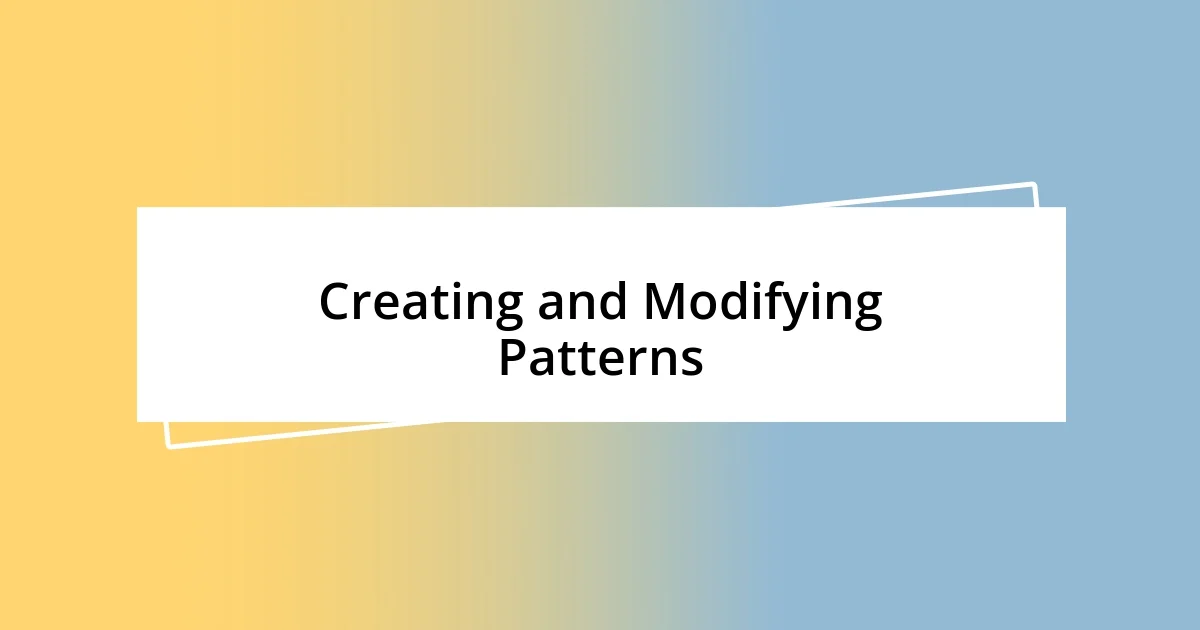Key takeaways:
- Understanding the different types of pattern making (flat patterns, draping, and digital patterns) and the importance of accurate measurements is crucial for successful designs.
- Essential tools like pattern paper, French curves, and measuring tape enhance the pattern making process and improve precision and confidence.
- Testing patterns through muslin mock-ups and documenting adjustments helps refine designs and prevent fitting issues, fostering a stronger connection to one’s work.

Understanding Pattern Making Basics
Pattern making is the bridge between design and construction, and I can’t emphasize enough how crucial it is to grasp the basics. When I first started, I remember feeling overwhelmed by the technical terms, but those initial struggles taught me to appreciate the precision involved. What’s fascinating is how creating a simple block can serve as the foundation for countless designs. Have you ever experienced that “aha” moment when everything clicks into place? It’s like unlocking a secret door in your craft.
One of the foundational concepts in pattern making is understanding the different types of patterns: flat patterns, draping, and digital patterns. Each method has its own charm and application. I often gravitated towards flat patterns because they felt the most structured and reliable for me. I still recall that exhilarating feeling when I drafted my first pattern—it was as if I had translated my ideas into something tangible. Don’t you find joy in seeing your visions take shape?
Another essential aspect is the importance of measurements and fitting. In my early days, I often skimped on this, thinking I could wing it. However, I quickly learned that precision matters immensely. Understanding body measurements and proportions saves you a world of heartache later on. Have you ever tried to fit a garment without accurate measurements? It’s a lesson I won’t forget, and those experiences shaped my approach to pattern making.

Essential Tools for Pattern Making
When I think about the essential tools for pattern making, I can’t help but recall the excitement I felt when I invested in my first set of supplies. Having the right tools not only enhances your accuracy but also boosts your confidence. I distinctly remember the day I purchased my trusty French curve; it felt like I was entering a new realm of precision. Each curve allows me to draft beautiful armholes and necklines that elevate my designs.
Here’s a quick list of tools that I consider indispensable for any aspiring pattern maker:
- Pattern Paper: Ideal for creating precise draft patterns without wasting fabric.
- French Curve: Perfect for drafting smooth curves and achieving professional-looking edges.
- Rulers (Straight and L-Square): Essential for drawing straight lines and right angles accurately.
- Measuring Tape: A must for taking body measurements and ensuring the perfect fit.
- Scissors: Sharp fabric scissors make cutting patterns clean and easy.
- Tracing Wheel and Carbon Paper: Excellent for transferring markings from your pattern to fabric effortlessly.
- Weights: Use these to keep your pattern in place while cutting—my go-to for a steady hand!
In my experience, each of these tools plays a significant role in bringing my visions to life. It’s fascinating how something as simple as a ruler can make such a difference in the outcome of a design. I encourage you to find tools that resonate with your personal style and workflow, as investing in quality equipment genuinely changes the game in pattern making.

Techniques for Accurate Measurements
One technique I find invaluable for accurate measurements is the use of a fitting muslin. When I first tried this method, it was a game-changer. I would create a mock-up of my garment using cheap muslin fabric. This allowed me to test not only the fit but also how the fabric would behave. Those early experiments taught me that seeing how the pattern fits on a real body is irreplaceable. Have you ever experienced the relief of altering a muslin instead of your precious fabric? It’s a risk-free way to ensure everything aligns perfectly before the final cut.
Another approach I rely on involves double-checking measurements. Many times, I’ve been guilty of rushing through this process, but I’ve learned that taking the time to measure twice can save me countless hours in adjustments. I like to use a flexible measuring tape because it can easily contour to the body’s curves. Working with clients, I’ve seen how mismeasured bust or waist lines can lead to frustrating fitting issues later. I’ve definitely felt that sinking feeling when trying to salvage a design due to an overlooked measurement; now, I can appreciate the importance of precision.
Lastly, I encourage the use of digital measuring tools. I recently started using a body scanner app that precisely captures measurements from all angles. It was intimidating at first, but the accuracy it offered was spectacular. This technique allowed me to broaden my designs to accommodate various body types without the guesswork. Have you ever felt stuck in a pattern rut? Embracing technology can often bring fresh perspectives to long-standing practices.
| Technique | Description |
|---|---|
| Fitting Muslin | Creating mock-ups in muslin helps test fit and fabric behavior. |
| Double-Checking Measurements | Taking time to measure twice reduces fitting issues and saves time. |
| Digital Measuring Tools | Using apps for precise measurements brings new accuracy and adaptability. |

Creating and Modifying Patterns
Crafting and adjusting patterns is where the magic really happens in design. I often find that when inspiration strikes, it can lead to a whirlwind of creativity. A few months back, I decided to modify a simple top pattern into a more intricate design. It was exhilarating to visualize how small changes, like altering the neckline or adding a ruffle, could completely transform the final look. Have you ever felt that surge of excitement when a new idea takes shape? I believe experimentation is key; don’t shy away from pushing the boundaries of your patterns.
When it comes to modifying a pattern, I always recommend starting with a pencil and some tracing paper. I remember a time I was working on a dress and wanted to add pockets. It dawned on me how easy it was to just trace the side seam and create a pocket piece—talk about a lightbulb moment! This handy method not only preserves the original pattern but also allows for creating multiple versions without the pressure of perfection. Each time I deepen my understanding of how different elements work together, my confidence as a pattern maker grows.
Another approach I treasure is to take notes on changes as I make them. Initially, I overlooked this crucial step, thinking I’d remember every small alteration. However, I learned the hard way when I couldn’t replicate a design I loved. Now, I keep a dedicated notebook filled with sketches and adjustments alongside my patterns. Have you ever faced the frustration of trying to remember what worked last time? I can’t stress enough how invaluable it is to have a record of those successes and learning experiences. It not only streamlines the design process but also builds a foundation of knowledge that you can draw from in the future.

Tips for Successful Fabric Cutting
Cutting fabric accurately is crucial to achieving the desired look in any project. One tip I swear by is using a sharp rotary cutter instead of traditional scissors. When I first made the switch, I was amazed at how clean and precise my cuts became. Those jagged edges from my scissors? A thing of the past! Have you ever noticed how a small change in tools can transform your entire workflow? It’s one of the easiest upgrades you can make.
Additionally, I’ve found that working on a flat, secure surface makes a world of difference. I remember a project where I attempted to cut on an uneven table—I ended up with pieces that didn’t match up. There’s nothing quite like the frustration of sewing together mismatched edges and seeing them fall short of your vision. Now, I always make sure my cutting table is properly adjusted and clear of clutter. This simple adjustment creates a calming workspace that enhances focus and precision.
One last technique I can’t recommend enough is to lay out the fabric in a single layer when dealing with complex patterns. It brings back memories of my early days, wrestling with layered fabric and getting tangled overlaps. That led to unwelcome surprises during assembly! Spreading the fabric out not only ensures you see each pattern piece but also allows for a more accurate alignment. Have you ever thought about how much frustration can be avoided simply by making this small adjustment? Trust me; it’s a small but mighty change that pays off in the long run!

Common Mistakes to Avoid
A common mistake I see, and have made myself, is neglecting the importance of body measurements. In my early days of pattern-making, I often skimped on this, assuming a size chart was enough. I still remember how disheartening it was to finish a piece only to find it wouldn’t fit properly. Now, I always take the time to measure accurately, ensuring that my designs cater to the exact dimensions needed. It’s a small step that pays off immensely, wouldn’t you agree?
Another pitfall I’ve faced is rushing the sewing process without proper planning. In one particular project, I was so eager to see my creation come to life that I skipped a few essential steps. The result? Uneven seams and unnecessary frustration. I’ve learned that taking the time to pin, baste, or even just pause for a moment to check my work saves me hours of fixing mistakes later on. Have you ever experienced that urge to hurry through, only to end up with regrets?
Lastly, overlooking fabric grain direction can lead to unexpected outcomes. Early on, I remember blithely cutting pieces without considering their alignment. When I finally wore that garment, I was stunned to see it didn’t drape or stretch as I expected. Now, it’s a non-negotiable part of my fabric preparation ritual to always check grain lines. Trust me; paying attention to these details can elevate your work from decent to stunning. Isn’t it remarkable how these small insights can transform the entire sewing experience?

Finalizing and Testing Your Patterns
Testing and finalizing my patterns is where the magic truly happens. I recall a project where I eagerly rushed to cut my fabric, only to realize the neckline was too tight during my fitting session. It was a tough pill to swallow, but this experience taught me the importance of making a muslin sample first. Have you ever experienced that moment of clarity when you see your pattern in action? It’s essential to test your designs, as it gives you the chance to make necessary adjustments without risking your fabric.
Once I’ve made adjustments to the original pattern, I like to conduct a thorough fitting. This involves trying the garment on multiple times and, if possible, having a friend assist me. I remember fiddling with the sleeve length repeatedly on one dress, adjusting it just a bit each time. Frustrating? Yes! But each iteration brought me closer to that perfect fit, and I still fondly recall how thrilled I was when I finally nailed it. It’s in these testing moments that I feel most connected to my work. How about you—do you have a fitting routine that works for you?
Finally, I believe in documenting my findings. After finishing adjustments, I jot down notes on what worked and what didn’t during the testing phase. I once neglected this step and later struggled to remember what adjustments I had made. It was a frustrating lesson! Now, I treat my notes like precious guides for future projects. Doesn’t it feel empowering to have a clear roadmap for your next creation? Engaging in this thorough process not only refines my patterns but also enhances my overall confidence as a maker.














